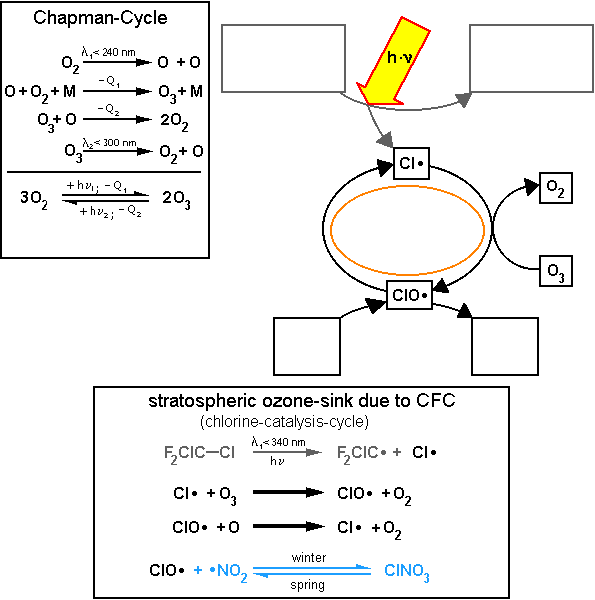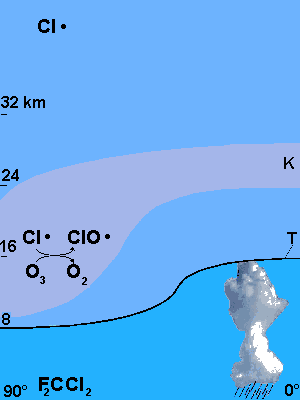|
|
 |
|
|
|
 |
| |
|
|
 |
Higher Atmosphere
Read more |
Worksheet 2
Transport, decomposition and effect of CFCs in the stratosphere
|
|
|
|
|
 |
|
T1 |
In Figure 1 you can see the Chapman-cycle of the ozone equilibrium and the chlorine-catalysis-cycle (CCC) depicted as a series of reaction steps and as a reaction cycle. The bold typed reaction arrows indicate that these elemental processes take place more often than the others (chain reaction).
Add the missing formulas into the four squares of the right part of Fig. 1 and fill into the empty oval shape the name of the reaction process. |
|
 |
 |
|
Figure 1: Chapman-cycle and chlorine-catalysis-cycle of stratospheric chemistry (-Q: dissipation of heat)
© 2004 Seesing, Tausch; Universität-Duisburg-Essen, Duisburg
|
|
|
T2 |
The CCC and the Chapman-cycle, that describes the "natural" equilibrium of ozone in the stratosphere, are linked to each other.
Mark the places where this linkage occurs in the reaction cycle from Fig.1 in red. Mark the same places also in the box with the Chapman-cycle. |
|
T3 |
Add the scheme of the cycle in Fig. 1 by showing the function of nitrogen dioxide as "preserving agent" for the chlorine oxide radicals. |
You have learned about the effect of CFCs on ozone. The chlorine catalysis cycle takes place some thousand times before the chlorine radicals react in another way or before they are transported out of the ozone layer. But how do the chlorine radicals, that for the greatest part originate from the CFCs, reach the ozone?
|
 |
 |
|
Figure 2: Layers of the atmosphere from the equator to the north pole (T: tropopause; K: area of the stratosphere with high concentration of ozone (>16 DU / km)
© 2004 Seesing, Tausch; Universität-Duisburg-Essen, Duisburg
|
|
 |
|
T4 |
Draw the main air flows of the stratosphere in Figure 2 and name them. |
|
T5 |
Mark the place in the tropopause line where there seems to be the smallest difference in temperature and where an exchange of matter seems most probable. |
|
T6 |
Write a reaction scheme of the photolysis of CFC (take F2CCl2 from Fig. 1 as an
example) at the place in Fig. 2 where the reaction is most likely to take place. |
|
T7 |
Now draw the imagined path of chlorine from the CFC (taking F2CCl2 as an example) to the place where the chlorine-catalysis takes place. | |
|
|
T8 |
Here are some statements on the CFC problem, on transport processes and on ozone. Mark the right statements with a cross. |
|
q |
The lifetime of CFCs is very long. It is long enough for the CFCs to move to the stratosphere even though the transfer is extremely slow. |
|
q |
The lifetime of CFCs is not very long, but the transport processes in the atmosphere are fast enough so the CFCs split after having reached the stratosphere. |
|
q |
Chlorine radicals directly split ozone. A product is formed which reacts with a reactant which is necessary for the formation of ozone. Therefore the new formation of ozone is hindered. |
|
q |
In the stratosphere many chlorine radicals are formed which then form stable compounds with ozone. Thus it becomes ineffective as UV-filter. |
|
q |
Since chlorine radicals catalyse the depletion of ozone only small quantities of CFC are necessary for a considerable depletion of ozone. |
|
q |
The catalytic depletion of ozone and the transport processes alone are not the only factors needed to explain the seasonal fluctuation of the ozone concentration in the atmosphere (ozone hole). |
|
About this page:
Authors: M. Seesing, M. Tausch - Universitšt Duisburg-Essen, Duisburg / Germany
Rewiewer:
Last update: 2004-05-13 |
|
 |
|









